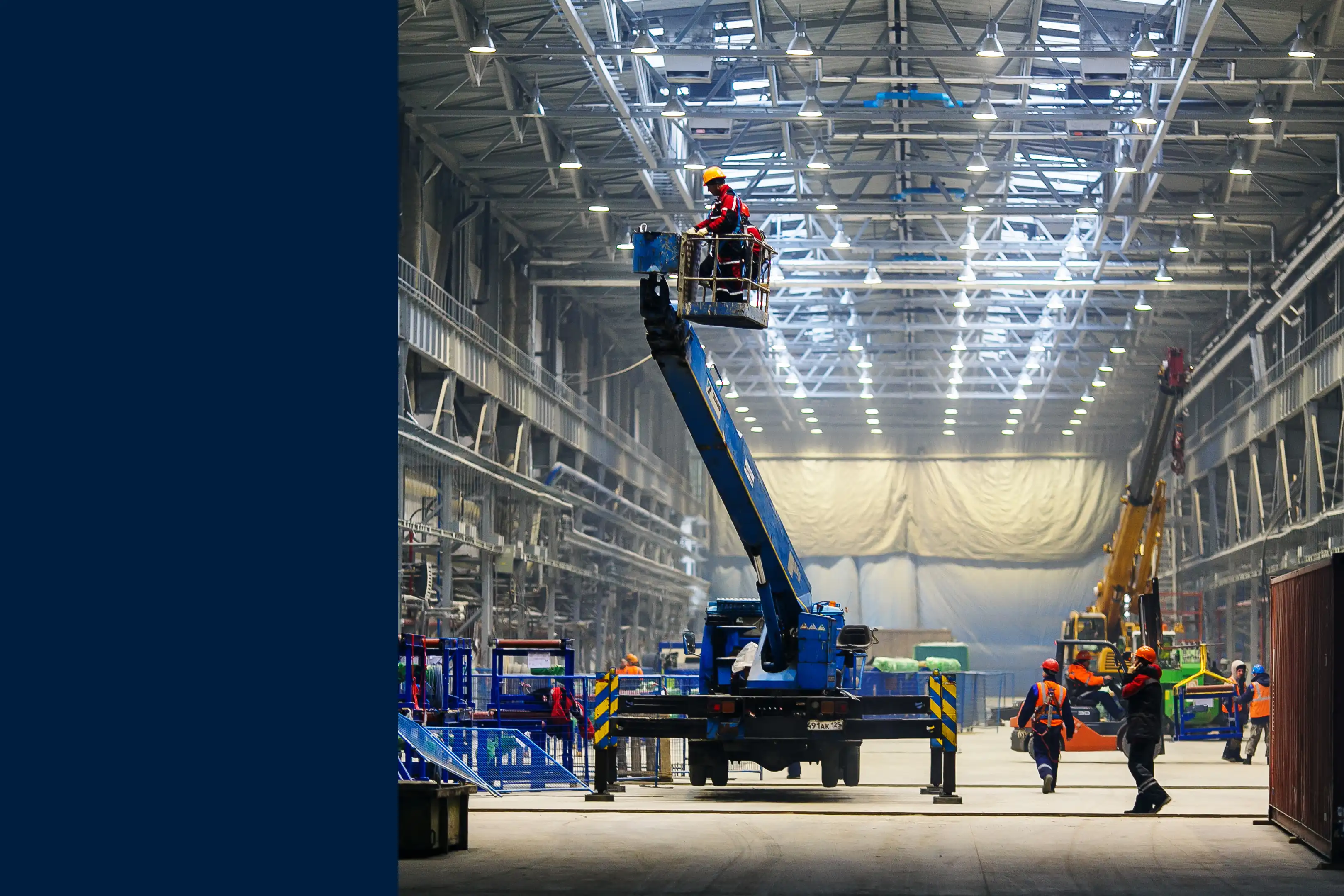
While preventive maintenance is one of your best bets for reducing unplanned downtime, unlocking greater efficiency, and optimizing your spending, tying maintenance to a rigid schedule can lead to over-maintenance and wasted resources.
Predictive maintenance can help you avoid these challenges. By predicting how equipment will fail and when that failure will occur, you can perform maintenance only when it’s needed while minimizing reactive maintenance as much as possible. Predictive maintenance is not an easy maintenance strategy to roll out, nor is it suitable for every asset. But when done right, it can help you better manage your resources, address issues with precision, and improve asset lifespans. Plus, you can reduce over-maintenance and increase asset availability.
Successful predictive maintenance relies on teams using the right software. That's why this article explores the best predictive maintenance software options, including key features to look for how to evaluate maintenance software so you know you're making the right choice.
What is predictive maintenance software?
Predictive maintenance software solutions help teams plan, execute, and manage predictive maintenance tasks. They typically include preventive maintenance modules such as work order management and scheduling tools, but also have asset monitoring and integration functions that facilitate predictive workflows.
By analyzing data from various sources, such as sensors, historical maintenance records, and operating conditions, predictive maintenance solutions can identify patterns and potential issues before they lead to equipment failure. The software can notify maintenance teams of these anomalies in asset performance and automatically schedule inspections or corrective maintenance based on the forecasted failure mode.
Top 10 predictive maintenance software solutions
There are several maintenance software vendors that offer predictive maintenance capabilities alongside their core features to help organizations begin or scale their journey. Here is a list of the top 10 predictive maintenance software solutions currently available.
1. MaintainX
MaintainX is an AI-powered, mobile-first computerized maintenance management system (CMMS) that offers automated work order management, seamless asset tracking, and robust integrations.
Predictive maintenance capabilities
- Seamless connection to sensors, PLCs, SCADA systems, MES platforms, and other data historians to establish real-time condition monitoring and anomaly detection.
- Usage and condition-based anomaly detection and work order scheduling via sensors and meters.
- Automatic work-order generation from sensor events (like temperature and liquid levels) to trigger maintenance when needed.
- Plug-and-play integrations with MachineMetrics, AssetWatch, Kepware, MQTT and other key predictive maintenance platforms.
- Asset-health dashboards and KPI analytics, plus AI-powered reporting.
Other key features
- Asset management and digital work orders
- IoT-enabled condition and usage-based maintenance
- Inventory and parts management
- Real-time reporting and analytics
- Mobile-first experience for frontline teams
- Native integrations with ERP, SCADA, IoT platforms, and more
2. IBM Maximo
IBM Maximo is an enterprise asset management platform leveraging AI and IoT for predictive maintenance and lifecycle management. While Maximo has a wide range of predictive maintenance features, this is mentioned in customer reviews as a downside as much as an advantage because of the complexity and steep learning curve these features require.
Predictive maintenance capabilities
- AI and machine learning features that analyze historical data, real-time IoT sensor readings, and maintenance records to anticipate failures.
- Condition monitoring and condition-based maintenance features that provide insight into asset health and potential anomalies.
- Centralized asset information, workflows, and inventory management.
- Custom reports and dashboards to visualize asset performance and maintenance work
Other key features
- Asset lifecycle management
- Predictive maintenance analytics
- Integration with IoT and AI
- Work order management
- Reporting and dashboards
3. SAP Predictive Maintenance and Service
SAP Predictive Maintenance and Service integrates data from SAP ERP with machine learning to execute real-time monitoring and predictive analytics.
Predictive maintenance capabilities
- Strong integration with SAP systems for seamless workflow.
- Advanced analytics and machine learning capabilities for accurate predictions.
- Comprehensive support for various industries.
- Real-time data collection from IoT sensors on equipment, such as temperature, vibration, or pressure, as well as operational data, like transaction history and asset performance records.
- Anomaly detection to forecast potential equipment failure, which is relayed as an asset health score and recommended maintenance actions with alerts.
Other key features
- Integration with SAP ERP
- Machine learning for predictive analytics
- Real-time monitoring of asset health
- Automated service processes
4. UpKeep
UpKeep is a mobile-focused CMMS designed for easy work order management, maintenance scheduling, and inventory tracking.
Predictive maintenance capabilities
- IoT condition monitoring via wireless sensors.
- Threshold-based alerts and incidents with email and SMS notifications.
- Automated work-order creation from sensor anomalies, with preloaded checklists.
- Usage and meter-based triggers that automatically generate work orders when thresholds are hit.
- AI that analyzes sensor data for early failure signs and PM scheduling.
Other key features
- Mobile-first CMMS
- Work order management
- Preventive maintenance scheduling
- Inventory management
- Maintenance reporting and analytics
5. Fiix
Fiix is a CMMS offering IoT integration, predictive analytics, and scalable asset management for organizations.
Predictive maintenance capabilities
- Anomaly detection and risk scoring based on sensor and historical data.
- Auto-creation of work orders based on failure predictions and condition or meter-based triggers
- Connection to common OT sources (PLCs, SCADA, sensors) requiring configuration and data mapping.
- Inventory forecasting offers directional estimates for ordering parts for upcoming maintenance.
Other key features
- Asset management
- Work order management
- Maintenance reporting and analytics
6. Limble
Limble is a CMMS with some standard condition monitoring features as well as common partner integrations that allow companies to get started with predictive maintenance tools.
Predictive maintenance capabilities
- IoT condition monitoring with modular, plug-and-play sensors and real-time insights.
- Threshold-based alerts and notifications and automatic data logging.
- Automated work-order creation from sensor anomalies.
- Usage and meter-based triggers that generate work orders when readings hit set thresholds.
- Integrations with IoT devices and EAM/ERP systems, including API support.
Other key features
- Mobile CMMS and work order management
- Preventive maintenance scheduling
- Inventory management
- Maintenance reporting and analytics
7. AssetWatch
AssetWatch is a predictive maintenance platform that combines wireless vibration and temperature sensors with AI and certified analysts to detect failures early and trigger maintenance in your CMMS.
Predictive maintenance capabilities
- Continuous condition monitoring with wireless sensors that stream vibration and temperature data for real-time asset health.
- AI anomaly detection and a dedicated condition monitoring engineer to validate findings and deliver prescriptive recommendations.
- Integrated lubrication and oil analysis to identify and act on wear mechanisms.
- Auto-create work orders in a CMMS when condition-based alerts are triggered.
Other key features
- Centralized dashboards with asset health views and dynamic ROI tracking
- Field support with local reliability technicians
- Integration with CMMS platforms
8. eMaint
eMaint is a CMMS platform with an integration with Fluke measurement tools for preventive and condition-based maintenance.
Predictive maintenance capabilities
- Ingest live data from sensors (exclusively Fluke sensors), and SCADA and PLC systems to monitor asset health.
- Set alarms and notifications for when condition-based thresholds are passed, and auto-create work orders for corrective work.
- Use AI diagnostics on vibration data to predict specific faults.
Other key features
- Mobile CMMS app
- Work order management and PM scheduling
- Inventory and purchasing
- Reporting and analytics dashboards
9. HxGN
HxGN (formally Infor) is an enterprise-grade asset management solution with predictive analytics and IoT integration designed for large-scale operations.
Predictive maintenance capabilities
- Use AI anomaly detection for prescriptive maintenance actions.
- Support real-time condition monitoring and digital twins to assess risk and predict failures.
- Convert APM insights into maintenance workflows and work orders.
- Use reliability-centered maintenance features, risk/criticality tools, and root-cause analysis.
Other key features
- Core asset and work order management
- Inventory, procurement, and warranty management
- Integrations across ERP/SCADA/PLC and other OT systems
10. Augury
Augury is an AI-driven machine health platform offering real-time condition monitoring and predictive maintenance insights to reduce downtime.
Predictive maintenance capabilities
- Continuously monitor machine performance with sensors.
- Diagnose component-level faults and generate prescribed fixes.
- Auto-create and sync work orders with CMMS and EAM systems.
Other key features
- Cutting-edge AI and machine learning capabilities focused on machine health.
- Provides precise predictive maintenance insights to prevent production downtime.
- Strong focus on reducing maintenance costs and extending asset life.
How to choose the best predictive maintenance software
Choosing the right predictive maintenance software can be overwhelming. Part of the challenge is that there are a lot of different predictive maintenance tools available. But for most maintenance teams, the bigger issue is that predictive maintenance is often a big change to their operations, one that comes with a lot of unfamiliar systems, terms, and workflows.
That’s why evaluating software vendors is not just about getting the right features, but also identifying a partner that will help you adopt the software and get the most out of it. the software.
Here’s a quick guide to help you navigate the selection process.
Identify your requirements and must-have predictive maintenance tools
Step one in the evaluation process should be clearly defining your organization’s specific maintenance needs and the goals of your maintenance program. Consider the type of assets you manage, the size of your operation, and the critical maintenance challenges you face. This can include:
- Workflows: You might require predictive maintenance software to automatically generate work orders and send notifications when a failure is predicted.
- KPIs: One of your goals or targets for a predictive maintenance tool may be to reduce downtime on a specific asset group.
- Support: Your must-haves can include a phased implementation and dedicated customer success representative to help you maximize value from the system.
Knowing these essentials will help you narrow down your options, avoid getting lost in the sea of software solutions, and find the solution that will improve asset reliability most.
Prioritize ease-of-use
No matter how powerful predictive maintenance tools are, they won't help you increase asset performance if your team can't use them. This is especially important with predictive maintenance software that relies on accurate and robust data entry by users. Look for software with an intuitive user interface that requires minimal training. Focus on ease of use in these areas:
- Data entry and data synchronization
- Connecting IT systems (like ERPs and MES) and OT systems (like PLCs or SCADA)
- Interpreting alarms, predictions, faults, and other data
- Creating and executing workflows
Ease-of-use ensures faster adoption, less resistance from users, and more consistent data entry and monitoring.
Ensure integration with existing systems
To get the best out of your predictive maintenance software, it should integrate seamlessly with your existing systems. These include:
- Enterprise resource planning (ERP) systems
- Computerized maintenance management systems (CMMS)
- Sensors, data historians, and other IIoT devices, like PLCs and SCADA
- Manufacturing execution systems (MES)
This integration enables the smooth flow of machine data from where it’s created to where your maintenance team can take action with it. This makes it easier to gain comprehensive insights into your operations, target unplanned downtime at its root, and improve your maintenance processes.
Look for robust predictive analytics capabilities
The core of predictive maintenance is condition monitoring and data analytics. Make sure the software you choose has advanced predictive analytics capabilities, including machine learning and real-time data analysis.
These predictive maintenance tools will allow you to accurately forecast maintenance needs, optimize scheduling, and reduce downtime. Also, look for predictive capabilities outside of anomaly detection, such as predictive forecasting for inventory management or operating costs.
Consider scalability and flexibility
As your organization grows, your maintenance needs will evolve. Choose predictive maintenance software that can scale with your business and adapt to changing requirements. This scalability ensures your predictive maintenance strategy remains effective, regardless of how your asset base or operations expand.
Evaluate support and training options
Even the best predictive maintenance tools require good support. Check if the vendor offers comprehensive support and training resources—not just in the initial implementation, but as you adopt the system and increase your usage. This might include:
- Dedicated implementation support, like importing data and setting up OT connections
- Access to customer service and customer success representatives
- Online tutorials, help guides, and continuing education
- User communities.
Strong support ensures that your team can effectively use the software, troubleshoot any issues that arise, and maximize the ROI you get from the platform.
Consider reporting and data analytics features
Whatever your maintenance program, predictive or otherwise, it’s important that you keep an eye on your performance to identify areas of improvement. Getting a software solution with robust reporting features will enable you to track your most critical KPIs at a glance, like:
- Mean time to repair (MTTR)
- Mean time between failure (MTBF)
- Anomalies identified and corrected
- False alarms
- Maintenance costs
It will also help you measure progress, identify potential mistakes, and optimize asset performance effectively. You’ll be able to eliminate errors, reduce reactive maintenance, and double down on what works.
Unlock the best predictive maintenance software with MaintainX CMMS
Ready to transform your maintenance operations? Implement predictive maintenance with the MaintainX’s CMMS. Designed to streamline your workflow, improve asset reliability, and increase equipment uptime, MaintainX offers the tools you need to utilize predictive maintenance to keep your assets and maintenance processes running smoothly and efficiently.
Asset and equipment management
- Centralize the tracking and management of all physical assets in complex industrial environments.
- Enable predictive maintenance by monitoring asset health and performance through data collection and analysis.
Reporting and analytics
- Provides custom dashboards and reports to analyze equipment performance.
- Helps identify trends and predict maintenance needs, reducing unplanned downtime.
Digital work orders
- Streamlines maintenance workflows by creating, assigning, and tracking work orders in real time, ensuring timely maintenance interventions based on predictive insights.
Inventory and parts management
- Tracks inventory levels and usage to ensure that necessary parts are always available, which is crucial for timely predictive maintenance actions.
Meters and sensor integration
- Allows real-time data collection from equipment, enabling predictive maintenance by monitoring asset conditions and triggering maintenance actions when predefined thresholds are met.
Frequently asked questions about predictive maintenance software
Are companies using AI for predictive maintenance of industrial equipment?
Many companies are increasingly leveraging Artificial Intelligence (AI) for predictive maintenance of industrial equipment. AI algorithms analyze vast amounts of sensor data to detect patterns and anomalies that may indicate potential equipment failures. This proactive approach allows businesses to predict maintenance needs before issues arise, minimizing downtime and optimizing the performance of critical assets.
How can predictive maintenance software enhance the longevity of a truck/vehicle fleet?
Predictive maintenance software can significantly enhance the longevity of a truck or vehicle fleet by continuously monitoring the health of each vehicle through sensors and diagnostic data. By identifying early signs of wear and tear, the software can alert maintenance teams to potential issues before they become serious, allowing for timely repairs. This proactive approach reduces the risk of major breakdowns, lowers maintenance costs, and extends the overall lifespan of the fleet.
How can machine learning be applied to predictive maintenance software strategies?
Machine learning can be applied to predictive maintenance software strategies by analyzing historical and real-time data to identify patterns that predict equipment failures. These algorithms learn from the data over time, becoming more accurate in forecasting when maintenance is needed. By using machine learning, organizations can achieve more precise predictions, optimize maintenance schedules, and reduce unnecessary maintenance activities, ultimately leading to cost savings and improved operational efficiency.
How do I know if predictive maintenance is right for my operation?
Predictive maintenance works best for physical assets that are critical to production, have measurable failure modes, and can support monitoring equipment (e.g., vibration, temperature, current). Start by reviewing downtime history and maintenance cost drivers, then analyze asset performance to find candidates with high impact and reliable data signals. If a pilot shows improved equipment health, fewer reactive work orders, and faster troubleshooting, you can expand—using data-driven insights to extend equipment life across similar assets.
How does predictive maintenance software integrate with our maintenance management stack?
A modern predictive maintenance solution ingests signals from PLCs, SCADA, and IoT devices, detects anomalies, and then pushes actions into your CMMS or ERP, auto-creating work orders, attaching condition data, and updating equipment health dashboards. This closed loop turns monitoring equipment into maintenance actions your team can execute, helping you extend equipment life, cut unplanned downtime, and continuously analyze asset performance with unified reporting.






